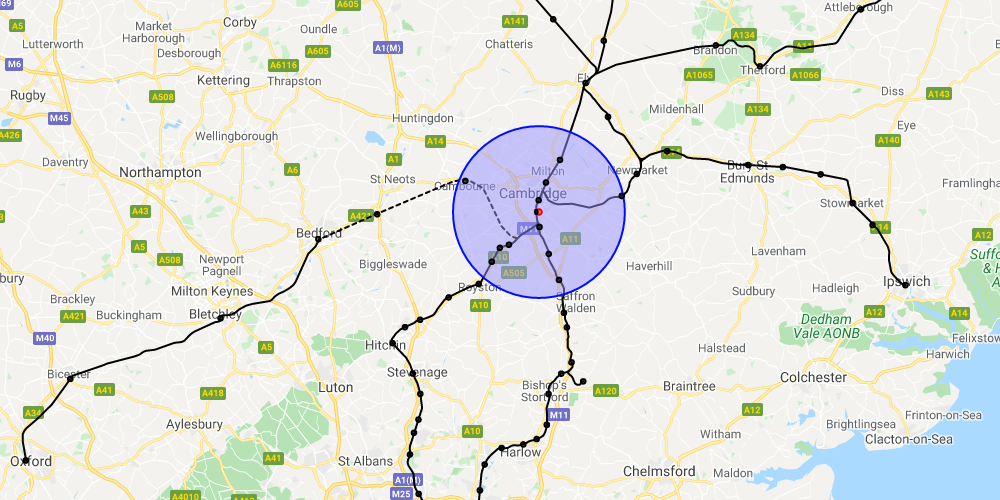Smarter Cambridge Transport presented its objection to the Transport and Works Act Order for Cambridge South station in a Proof of Evidence, submitted on 7 January 2022 (see below), and in a presentation, given on 18 February, reproduced (with a correction) here:
Closing statement
We agree with the applicant that:
- The forecast rail demand for Cambridge South station has been calculated using standard modelling methodologies, the correct application of which has been independently verified.
- The proposed station configuration is highly constrained by the Guided Busway bridge. All available space to the east of the tracks will be used, leaving none for future expansion.
- Our alternative proposal for a larger station, closely integrated with bus stops, would cost more, take longer to delivery, and require longer possessions of the railway.
However, on these points, we disagree with the applicant, and instead contend that:
- Standard modelling techniques are not appropriate for Cambridge South station because the Cambridge Biomedical Campus (CBC) is nationally unique in its high concentration of employment and regional hospitals – all potentially within a 15-minute walk of the station.
- The modelling severely underestimates the likely rate of growth beyond 2031 – from 27,000 jobs in 2031 to potentially 40,000 in 2041 (OBJ-22-APX CBC Vision 2050) –, even though continued rapid growth is desired and supported by government.
- TAG permits the applicant to seek agreement with DfT to use a bespoke demand model.
- Road capacity constraints in and around the CBC will drive modal choice in the future, as parking capacity constraints already do for staff. Therefore, road capacity needs to be included as an input parameter in the demand model, which currently it is not.
- The Williams–Shapps Plan for Rail white paper, the National Bus Strategy and the Transport Decarbonisation Plan are material considerations for planning purposes, even if they are not yet backed by detailed delivery plans. They place a responsibility on all stakeholders, including Network Rail, to make reasonable efforts at every opportunity to maximise use of sustainable transport modes, including rail and bus, and to deliver on a clearly stated intent that, “Railway stations should be hubs for connecting [bus] services with high quality stops close to station entrances.”
- It would not be reasonable nor good practice to design infrastructure on the basis that policies and actions that are uncertain, or not yet supported by funded delivery plans, will not be realised within the lifetime of the infrastructure.
We hold to the conclusions presented in our evidence that:
- If you accept the applicant’s demand forecast, then you must also conclude that planned growth in staff and visitors to the CBC cannot be achieved, because the demand to travel by car will exceed the capacity of the roads. The project funder should be advised of this.
- If you accept that there is a reasonable possibility that the outturn will significantly exceed the applicant’s demand forecast, then the applicant should be required to conduct more detailed scenario-testing with input parameters that include both physical and likely policy constraints on road traffic onto the CBC. Those policies include the Greater Cambridge Partnership’s objective of reducing traffic by 10–15% on 2011 levels, the Combined Authority’s objective of reducing total distance driven across the region by 15%, and the statutory decarbonisation milestones – 68% reduction relative to 1990 levels by 2030, 78% by 2035 and 100% by 2050 (mentioned in my oral evidence).
- As one of the project objectives (NRE11.2 6.2.3.i) is to “Improve sustainable transport access to housing, services, and employment within the Cambridge Southern Fringe and Biomedical Campus area, to fulfil existing and future demands” [my emphasis], Network Rail must work with all relevant stakeholders, including Cambridgeshire County Council, the Greater Cambridge Partnership, the Combined Authority of Cambridgeshire and Peterborough, East West Rail, East West Main Line Partnership, Great British Railways and the Department for Transport, to develop a package of measures to ensure that growth of the CBC can continue within the constraints of the road network, and still achieve targets on road traffic reduction, air quality improvement, and decarbonisation.
- The output of that exercise will be a significantly higher rail demand forecast and a revised parameter plan for the station access. Those together will require a different configuration and design for the station and its accesses, potentially along the lines we have proposed.
- More demand to use the station equates to higher user benefits, which therefore warrants a higher investment for the same benefit-cost ratio (BCR).
- Delay in delivering Cambridge South station and disruptions to existing rail services can be mitigated. Some of our evidence begins to explore how that may be achieved, noting that Cambridge station is connected to the CBC by a congestion-free busway, and that diversionary routes are available, and may be enhanced with relatively small investment.
We further recommend that:
- To minimise delay in delivering Cambridge South station in the event that the Inspector agrees with either of our headline objections, Network Rail should start now to develop and cost an alternative station configuration, along the lines we have proposed (and similar to the Abbey Wood Crossrail station, mentioned by Mr Barnes in his oral evidence).
Public Inquiry document downloads
- Proof of Evidence (PDF)
- Spreadsheet of data (Excel)
- Presentation (PDF)
- Summary Statement (PDF)



Add comment